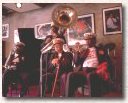|
Is climate change making our planet a more dangerous place to be?
A hotter planet means more insects, longer breeding seasons and the spread of insect-borne diseases.
What can be done?
|
|
 Join photojournalist and filmmaker Barbara Pyle as she meets two New Orleans natives who may have some answers on how to beat the heat and minimize the effects of climate change. Join photojournalist and filmmaker Barbara Pyle as she meets two New Orleans natives who may have some answers on how to beat the heat and minimize the effects of climate change.
|
|
 New Orleans Mosquito and Termite Control Board scientist Ed Bordes is studying one possible sign of climate change: increases in the number of termites and mosquitoes invading “The Big Easy.” New Orleans Mosquito and Termite Control Board scientist Ed Bordes is studying one possible sign of climate change: increases in the number of termites and mosquitoes invading “The Big Easy.”
|
|
 Join Ed and his team of bug-busters as they search New Orleans’ famous French Quarter for the insatiable formosan termite. Unlike other termite terminators, the bait Ed uses does not harm the environment. Ed says “There are only two kinds of buildings in New Orleans... Those that have termites and those that will.” He also employs an unusual ally and arsenal in his fight against mosquitoes: chickens. Find out how the birds help Ed pinpoint areas in the city where mosquitoes could be spreading diseases. Join Ed and his team of bug-busters as they search New Orleans’ famous French Quarter for the insatiable formosan termite. Unlike other termite terminators, the bait Ed uses does not harm the environment. Ed says “There are only two kinds of buildings in New Orleans... Those that have termites and those that will.” He also employs an unusual ally and arsenal in his fight against mosquitoes: chickens. Find out how the birds help Ed pinpoint areas in the city where mosquitoes could be spreading diseases.
|
|
 Another New Orleans native, Kit Senter, shows Pyle how everyone can slow climate change right in their own homes. Called by some “a one woman environmental protection agency,” Kit demonstrates how we can reduce our fossil fuel consumption by using energy-efficient light bulbs, shade trees and insulation. Another New Orleans native, Kit Senter, shows Pyle how everyone can slow climate change right in their own homes. Called by some “a one woman environmental protection agency,” Kit demonstrates how we can reduce our fossil fuel consumption by using energy-efficient light bulbs, shade trees and insulation.
|
|
Kit and Ed prove how innovative methods - some old and some new-can help “leapfrog” one to the most efficient, clean technologies, by literally jumping over the old, dirtier technology to the new.
|
|
|

|
Click here to view episode transcript
|
|
|

